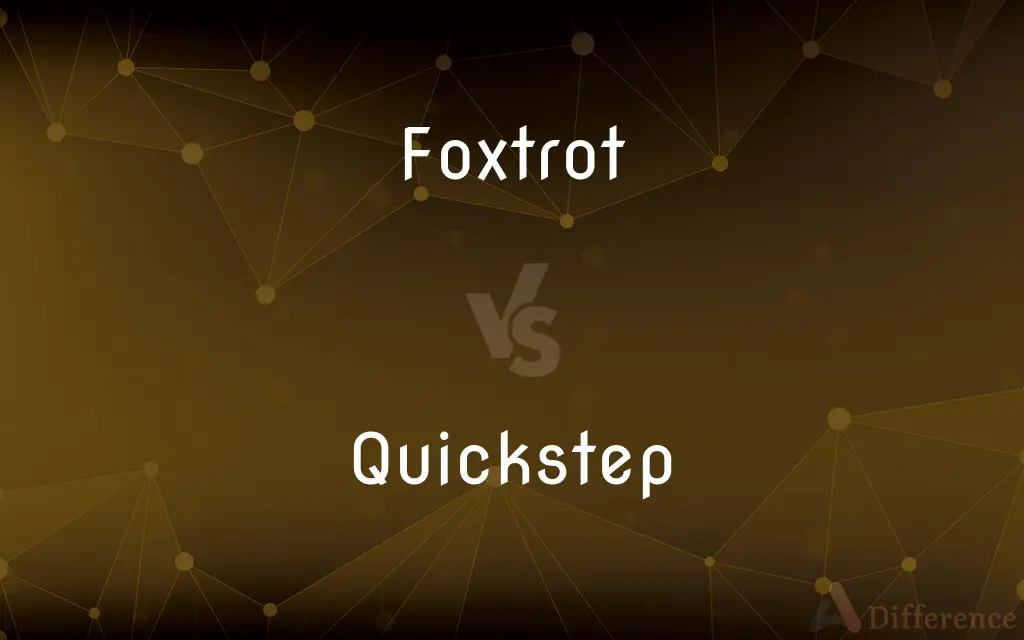Foxtrot vs. Quickstep — What's the Difference?
By Tayyaba Rehman — Updated on November 7, 2023
Foxtrot is a smooth, progressive dance characterized by long, continuous flowing movements, while Quickstep is a fast-paced dance that includes advanced patterns like runs and locks.

Difference Between Foxtrot and Quickstep
Table of Contents
ADVERTISEMENT
Key Differences
The Foxtrot and the Quickstep are both ballroom dances, but they differ in tempo, style, and energy. The Foxtrot is danced to slower music and is characterized by its smooth, flowing movements, giving dancers a sense of elegance and formality. In contrast, the Quickstep is lively and fast, performed to more upbeat music, making it appear more dynamic and exuberant.
Foxtrot dancers take long, easy strides, with an emphasis on seamless gliding across the dance floor, often to the rhythm of jazz or the same genre of music. Quickstep requires dancers to appear light on their feet, with a series of quick steps and syncopated rhythms that can include hops, runs, and rotations, typically to faster-paced swing or jazz music.
Historically, the Foxtrot originated in the 1910s and quickly became a favorite in the ballroom due to its easygoing style. The Quickstep evolved from the Foxtrot and the Charleston in the 1920s, developing into a distinctively brisk dance that demands a high level of skill and stamina from its performers.
While the Foxtrot is known for its smoothness and ease, allowing for improvisation and personal style, the Quickstep is structured and energetic, often requiring strict adherence to technique and timing. Both dances are staples in ballroom competitions and are judged on criteria specific to their style, such as timing, footwork, and expression.
In terms of music, the Foxtrot typically accompanies a song with a time signature of 4/4, with the dancers taking two slow steps followed by two quick steps. The Quickstep, however, is often performed to music with a faster tempo, and the dancers' movements are syncopated to the quick rhythm of the song, giving the dance its characteristic pace and vivacity.
ADVERTISEMENT
Comparison Chart
Tempo
Slower, allowing for smooth and continuous movement
Fast-paced with a lively tempo
Historical Origin
Originated in the 1910s
Evolved from the Foxtrot in the 1920s
Characteristic Movement
Long, flowing movements and strides
Quick, light steps with advanced patterns
Music
Typically set to 4/4 time jazz or similar genres
Faster swing or jazz music
Competition Criteria
Judged on smoothness, timing, and expression
Judged on precision, speed, and technique
Compare with Definitions
Foxtrot
A smooth, progressive dance characterized by long, continuous flowing movements.
They glided across the floor with the elegance of the Foxtrot.
Quickstep
A fast-paced ballroom dance with quick footwork and lively energy.
They practiced the Quickstep, their feet moving in a blur.
Foxtrot
A dance that emphasizes smoothness and ease.
The couple's Foxtrot was the highlight of the evening.
Quickstep
A dance that evolved from the Foxtrot and the Charleston.
The Quickstep added a spirited tempo to the evening's dances.
Foxtrot
A ballroom dance performed to jazz or similar music.
The band struck up a tune perfect for a Foxtrot.
Quickstep
Requires lightness on the feet and a high level of technical skill.
Their mastery of the Quickstep won them the competition.
Foxtrot
A dance with a simple combination of slow and quick steps.
Beginners often start with the basic steps of the Foxtrot.
Quickstep
Characterized by runs, locks, and syncopated rhythms.
Their Quickstep routine was a display of perfect timing and coordination.
Foxtrot
An adaptable dance allowing for improvisation and personal style.
They added their own twist to the classic Foxtrot.
Quickstep
Often danced to fast-paced swing or jazz music.
The orchestra's upbeat tempo was ideal for the Quickstep.
Foxtrot
A ballroom dance with a slow-slow-quick-quick rhythm.
Quickstep
The quickstep is a light-hearted dance of the standard ballroom dances. The movement of the dance is fast and powerfully flowing and sprinkled with syncopations.
Foxtrot
The foxtrot is a smooth, progressive dance characterized by long, continuous flowing movements across the dance floor. It is danced to big band (usually vocal) music.
Quickstep
A march for accompanying quick time.
Foxtrot
To dance the fox trot.
Quickstep
A fast foxtrot noted for its complex and intricate footwork.
Foxtrot
A pace with short steps, as in changing from trotting to walking.
Quickstep
To dance the quickstep.
Foxtrot
(international standards) nodot=1 NATO/ICAO Phonetic Alphabet.}}
Quickstep
To move with a hurried step.
Foxtrot
To dance the foxtrot.
Quickstep
A lively, spirited march; also, a lively style of dancing.
Foxtrot
A ballroom dance in quadruple time; combines short and long and fast and slow steps fixed sequences
Quickstep
Military march accompanying quick time
Foxtrot
Dance the foxtrot
Quickstep
A ballroom dance with both quick and slow steps
Quickstep
Perform a quickstep
Common Curiosities
What music suits the Foxtrot?
Jazz or similar genres with a 4/4 time signature.
What is the Foxtrot dance?
A smooth, progressive ballroom dance with long, flowing movements.
What is the Quickstep dance?
A fast-paced ballroom dance with light, quick footwork.
Is the Quickstep suitable for novice dancers?
It's more challenging due to its speed and technicality.
What characterizes the movement in Foxtrot?
Long, continuous, and easy strides.
How do the tempos of Foxtrot and Quickstep compare?
Foxtrot is slower and smooth; Quickstep is fast and lively.
What music is best for Quickstep?
Upbeat swing or jazz music.
What are characteristic movements of Quickstep?
Quick steps, runs, and syncopated rhythms.
Where did the Foxtrot originate?
It originated in the USA in the 1910s.
How did the Quickstep develop?
It evolved from the Foxtrot and Charleston in the 1920s.
Can beginners learn the Foxtrot easily?
Yes, the Foxtrot's basic steps are beginner-friendly.
Are improvisation and personal style important in Foxtrot?
Yes, Foxtrot allows for personal expression within its framework.
Does Quickstep allow for improvisation?
It's more structured, focusing on technique and timing.
What are judges looking for in a competitive Foxtrot?
Smoothness, timing, and expression.
What do judges focus on in a competitive Quickstep?
Precision, speed, and proper technique.
Share Your Discovery

Previous Comparison
Obsolescent vs. Obsolete
Next Comparison
Fury vs. FuriousAuthor Spotlight
Written by
Tayyaba RehmanTayyaba Rehman is a distinguished writer, currently serving as a primary contributor to askdifference.com. As a researcher in semantics and etymology, Tayyaba's passion for the complexity of languages and their distinctions has found a perfect home on the platform. Tayyaba delves into the intricacies of language, distinguishing between commonly confused words and phrases, thereby providing clarity for readers worldwide.
















































